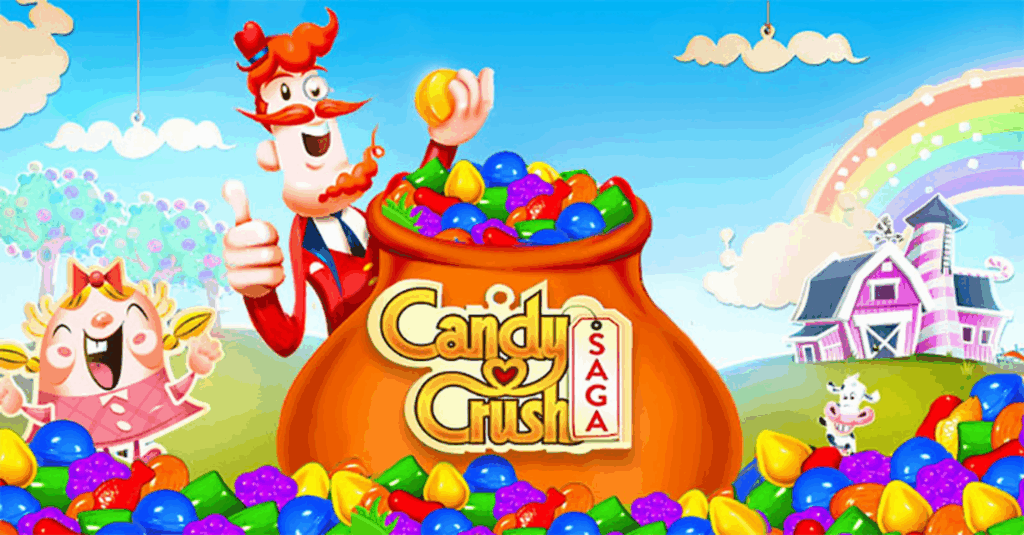Anúncios
Candy Crush has become more than just a mobile game; it’s a global phenomenon that has captivated millions since its release.
From its vibrant, candy-coated visuals to its addictively simple gameplay, this puzzle game has managed to carve out a unique space in the world of digital entertainment.
Anúncios
But how did this sweet success story begin, and what makes it so incredibly irresistible?
In this deep dive, we’ll explore the fascinating origins of Candy Crush, uncovering how a small idea evolved into one of the most profitable mobile games of all time.
Anúncios
We’ll also examine the psychology behind its addictive mechanics, shedding light on why players keep coming back for more.
Whether you’re curious about the game’s design secrets, its impact on the gaming industry, or the science of player engagement, there’s a lot to unwrap in this journey through Candy Crush’s sugary empire.
Stay tuned as we peel back the layers of one of the most iconic games in history, exploring the perfect blend of innovation, strategy, and just a dash of digital indulgence that keeps players hooked.
From casual gamers to die-hard fans, there’s something undeniably fascinating about the way this simple game has transformed into a cultural and financial powerhouse.
Peeling Back the Layers: The Origins of Candy Crush Saga
A Sparkling Beginning: The Birth of a Digital Phenomenon
In the bustling heart of London’s tech scene, a modest company named King unleashed a game that would soon dominate the digital world. In 2012, Candy Crush Saga made its debut, shrouded in sugary charm and addictive gameplay. What began as a simple puzzle game evolved into a cultural phenomenon, luring millions into its vibrant, candy-coated universe.
The origins of Candy Crush Saga trace back to humble beginnings. Its creator, Riccardo Zacconi, along with his team at King, aimed to build a game that was both accessible and endlessly entertaining. The key? A seemingly innocent combination of bright colors, gratifying sounds, and a simple yet challenging mechanic.
What no one could anticipate, however, was how quickly this digital confection would sink its hooks into the hearts and minds of players worldwide.
At its core, the game draws inspiration from classic match-three puzzles, but its genius lies in its subtle complexities. From limited moves to carefully calibrated difficulty spikes, every element is engineered to keep you coming back for just one more level. It’s not just a game; it’s a masterpiece of psychological design, crafted to grip the player in a sticky-sweet web of addiction.
The Hidden Hand of Behavioral Psychology
What makes Candy Crush so irresistible? The answer lies in its manipulation of human psychology. The game employs a series of cleverly designed mechanisms to tap into the brain’s reward system. For example, the burst of color and sound when candies align is no accident. This triggers the release of dopamine, a neurotransmitter associated with pleasure and satisfaction.
Moreover, the game’s progression system is carefully structured. Early levels are deceptively easy, designed to hook the player with a sense of accomplishment.
But as the levels become more challenging, frustration sets in—yet not enough to deter you. Instead, it entices you to keep trying, feeding on the human drive for mastery and success.
And then, of course, there are the infamous microtransactions. By limiting lives and offering in-game purchases as a shortcut, Candy Crush capitalizes on impatience. Suddenly, spending a few dollars to continue playing doesn’t seem so unreasonable. It’s a devilish strategy, one that blurs the line between entertainment and exploitation.
The Addiction Blueprint: What Keeps Players Hooked
The Art of Variable Rewards
One of the most potent tools in Candy Crush’s arsenal is the concept of variable rewards. Borrowed from the world of gambling, this psychological trick keeps players engaged by offering unpredictable outcomes.
You never know when a cascade of matches will clear the board, or when a lucky candy will tip the scales in your favor. This unpredictability creates a cycle of hope and excitement, making it nearly impossible to put the game down.
Variable rewards are further amplified by the game’s social features. By allowing players to connect with friends, Candy Crush introduces a layer of competition and camaraderie. Seeing a friend surpass your high score or conquer a difficult level stirs a mix of envy and motivation. The result? A digital arms race, where the stakes are pride and progress.
The Illusion of Choice
Another key element of Candy Crush’s allure is the illusion of choice. Each level presents a multitude of possible moves, giving the player a sense of control.
But in reality, the game often nudges you toward specific actions. Whether it’s through subtle hints or the strategic placement of candies, your choices are rarely as free as they seem. This clever manipulation keeps the player engaged, fostering the belief that victory is always within reach.
And yet, the game is not without its frustrations. Who hasn’t spent hours stuck on a particularly tricky level, only to finally succeed through a combination of skill and sheer luck? It’s a delicate balance, one that keeps players teetering on the edge of triumph and despair. This emotional rollercoaster is part of what makes Candy Crush so unforgettable—and so addictive.
A Cultural Confection: The Global Impact of Candy Crush
From Casual Game to Worldwide Obsession
Candy Crush Saga is more than just a game; it’s a cultural touchstone. With over a billion downloads and counting, it has transcended the realm of mobile gaming to become a global phenomenon. Its influence can be seen in everything from memes to merchandise, cementing its status as a pop culture icon.
Part of the game’s widespread appeal lies in its accessibility. Unlike traditional video games, which often require expensive hardware and a steep learning curve, Candy Crush can be played by anyone with a smartphone. Its intuitive design and bite-sized levels make it perfect for killing time, whether you’re on a coffee break or a long commute.
But the game’s impact goes beyond mere entertainment. It has sparked debates about the ethics of game design, particularly in relation to its use of microtransactions and addictive mechanics. Critics argue that games like Candy Crush exploit vulnerable players, turning a harmless pastime into a costly habit. Yet for many, the joy of playing outweighs the potential pitfalls, proving that the allure of candy-coated fun is hard to resist.
The Rise of “Freemium” Gaming
Candy Crush Saga also played a pivotal role in popularizing the “freemium” model of game development. By offering the game for free while charging for optional extras, King tapped into a lucrative market. This approach has since been adopted by countless other games, from Clash of Clans to Fortnite, reshaping the landscape of the gaming industry.
The success of Candy Crush has even influenced other forms of entertainment. Its addictive mechanics have been studied by app developers, marketers, and even psychologists, all eager to understand the secrets of its success. In many ways, the game has become a blueprint for modern digital design, proving that sometimes, the simplest ideas are the most powerful.
The Dark Side of Sweetness: Ethical Questions and Controversies
Exploitation or Entertainment?
While Candy Crush Saga is undeniably entertaining, it has also faced its fair share of criticism. At the heart of the controversy is its use of microtransactions.
By offering players the option to buy extra lives, boosters, and other in-game advantages, the game blurs the line between skill and financial investment. For some, this raises ethical concerns, particularly when it comes to younger or more vulnerable players.
There’s also the issue of time. Many players report losing hours—or even days—chasing the next level. This has led to accusations that games like Candy Crush are designed to be intentionally addictive, prioritizing profit over player well-being. While King has defended its practices, the debate continues, highlighting the complex relationship between gaming and mental health.
The Psychology of Pay-to-Win
Another controversial aspect of Candy Crush is its “pay-to-win” model. While the game is technically free, its reliance on microtransactions means that players who are willing to spend money often have a significant advantage. This creates a two-tiered system, where success is determined not just by skill, but by financial resources.
For some, this undermines the integrity of the game, turning it into a battle of wallets rather than wits. Yet for others, the option to pay for progress is a welcome convenience, allowing them to enjoy the game on their own terms. It’s a divisive issue, one that underscores the broader challenges facing the gaming industry as a whole.
The Sweet Symphony of Success: How Candy Crush Changed Gaming Forever
An Unforgettable Legacy
Love it or hate it, there’s no denying the impact of Candy Crush Saga. Its blend of simple gameplay, psychological design, and cultural relevance has made it one of the most successful mobile games of all time. And while its addictive mechanics may be controversial, they are also a testament to the game’s brilliance. After all, creating something that captivates millions is no small feat.
As we unwrap the story of Candy Crush, it’s clear that its success is no accident. From its origins in a London startup to its status as a global phenomenon, every aspect of the game is meticulously crafted to delight, frustrate, and enthrall. It’s a testament to the power of design—and a reminder that sometimes, the sweetest things in life come with a hint of darkness.

Conclusion: Unwrapping the Enduring Allure of Candy Crush
In conclusion, Candy Crush Saga stands as a shining example of how a seemingly simple concept can evolve into a global sensation. Its journey, from the creative minds at King to billions of downloads worldwide, highlights the power of innovative design paired with a deep understanding of human psychology.
Through its vibrant visuals, captivating gameplay, and carefully crafted difficulty curve, the game has managed to balance entertainment with challenge, keeping players engaged for over a decade.
However, Candy Crush’s success is not without its complexities. The game’s use of microtransactions and “pay-to-win” mechanics has sparked significant ethical debates, particularly regarding its impact on vulnerable players. Yet, it’s this very model that has reshaped the gaming industry, solidifying the “freemium” model as a dominant force in mobile gaming.
Ultimately, the legacy of Candy Crush Saga transcends its digital candy-coated world. It has not only influenced countless other games but also left an indelible mark on modern culture.
Whether celebrated for its addictive gameplay or critiqued for its controversial practices, Candy Crush remains an undeniable icon of mobile gaming. Its enduring popularity serves as a testament to the profound ways that innovation and psychology can shape entertainment in the digital age.



